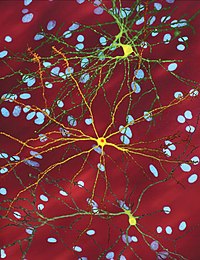
Photo from wikipedia
Background Huntington’s disease (HD) is a progressive neurodegenerative disorder caused by CAG expansion in the Huntingtin gene. HD manifests by involuntary movements, cognitive and behavioral changes. The approximate time-to-onset can… Click to show full abstract
Background Huntington’s disease (HD) is a progressive neurodegenerative disorder caused by CAG expansion in the Huntingtin gene. HD manifests by involuntary movements, cognitive and behavioral changes. The approximate time-to-onset can be predicted from the length of CAG repeat in HD subjects, which allows for the identification of subjects in the pre-manifest stage of HD, who do not have symptoms or structural brain changes (atrophy). Disease modifying treatment may have special value if it is initiated in the premanifest stage of HD, before structural brain changes occur. Aim Cortico-striatal functional connectivity may be altered in HD many years before symptoms onset. Thus cortico-striatal functional connectivity as assess by functional Magnetic Resonance Imaging (fMRI) may be a promising biomarker to be used for trials of disease modifying treatment. In particular, fMRI may of special interest to assess disease progression in HD subjects in the pre-manifest stage who do not have symptoms clinically. Question Is cortico-striatal functional connectivity in HD as assessed by fMRI at 7 T a biomarker for disease progression? Method We assessed 24 pre-manifest HD subjects, 12 manifest HD subjects as well as 16 healthy controls at baseline. 13 HD subjects (9 in the pre-manifest stage of HD) and 8 healthy controls participated in a one year follow-up study. The functional connectivity between the striatum and several cortical areas were analysis. Two tailed t-test was applied. ANOVA was used for the analysis of the one year follow-up data with group as between-subjects factor and time as within-subjects factor. Results Functional connectivity between striatum and supplementary motor area was impaired comparing manifest HD subjects with controls (p = 0.01) and premanifest HD subjects with controls (p = 0.03) at baseline. At the one year follow-up, functional connectivity between striatum and premotor area was impaired comparing manifest HD subjects with controls (group p = 0.002, time p = 0.04, group by time p = 0.02). Likewise, premanifest HD subjects showed decline compared to control subjects over time (group p Conclusion These data indicate progressive impairment of functional connectivity between striatum and premotor area in HD subjects. Assessment of cortico-striatal functional connectivity by fMRI is a promising biomarker to assess disease progression including the premanifest stage of HD, when subjects do not have symptoms.
Journal Title: Clinical Neurophysiology
Year Published: 2018
Link to full text (if available)
Share on Social Media: Sign Up to like & get
recommendations!